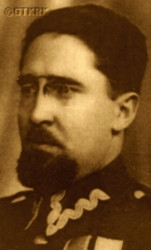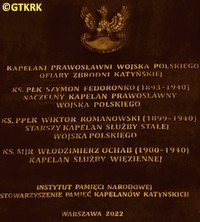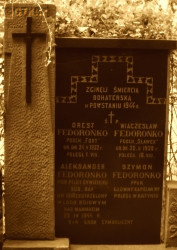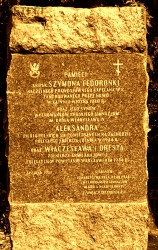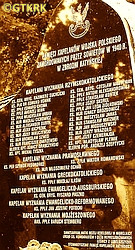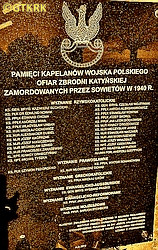Roman Catholic
St Sigismund parish
05-507 Słomczyn
85 Wiślana Str.
Konstancin deanery
Warsaw archdiocese, Poland
full list:
displayClick to display full list

searchClick to search full list by categories
wyświetlKliknij by wyświetlić pełną listę po polsku

szukajKliknij by przeszukać listę wg kategorii po polsku

Martyrology of the clergy — Poland
XX century (1914 – 1989)
personal data
surname
FEDOROŃKO
surname
versions/aliases
FEDORENKO
forename(s)
Simon (pl. Szymon)
function
presbiter (i.e. iereus)
creed
Eastern Orthodox Church ORmore on
en.wikipedia.org
[access: 2014.09.21]
diocese / province
Volyn‐Zhytomyr OR eparchymore on
ru.wikipedia.org
[access: 2023.07.16]
OR Military Ordinariate of Polandmore on
pl.wikipedia.org
[access: 2024.12.13]
honorary titles
„White Eagle” Ordermore on
en.wikipedia.org
[access: 2019.04.16]
(06.11.2018)
War Order of Virtuti Militari — Silver (5th Class)more on
en.wikipedia.org
[access: 2019.10.13]
(11.11.1976, Londontoday: London Cou., England, United Kingdom
more on
en.wikipedia.org
[access: 2024.03.19], decree of Stanislav Ostrowski, President of the Republic of Poland in exile)
September Campaign Crossmore on
pl.wikipedia.org
[access: 2023.11.24]
(01.01.1986, Londontoday: London Cou., England, United Kingdom
more on
en.wikipedia.org
[access: 2024.03.19], decision of George Premyslav Morawicz, Minister of Military Affairs of the Polish Government in exile)
Gold „Cross of Merit”more on
en.wikipedia.org
[access: 2019.04.16]
Silver „Cross of Merit”more on
en.wikipedia.org
[access: 2019.04.16]
(19.03.1931)
Ten Years of Independence Medalmore on
pl.wikipedia.org
[access: 2019.10.13]
„For Long Service” medal — bronzemore on
en.wikipedia.org
[access: 2020.05.25]
Allied Victory Medal, i.e. Fr. Interalliee de la Victoire (France)more on
pl.wikipedia.org
[access: 2023.02.20]
(c. 1937)
nationality
Ruthenian
date and place
of death
29.04.1940

NKVD Katynholiday resort
form.: Kozye Gory forest
today: Smolensk reg., Smolensk oblast, Russia
more on
en.wikipedia.org
[access: 2020.09.24]
alt. dates and places
of death
30.04.1940, 01.05.1940
details of death
During World War I, during the escape of the Russians — after the defeat in the Battle of Gorlice in 05.1915 — from Eastern Galicia occupied by them since 08.1914 (part of the so‐called bezhenstvo, escape of c. 3 mln Russians — officials, teachers, soldiers, Ortodox clergy — from Polish territories), went east, into Russia. Resided in Zhytomyr and Kiev.
After the end of World War I, prob. took part in the battles for the borders of the Second Polish Republic, including the Polish–Russian war of 1919‐1921 (perhaps to Poland returned during the so‐called Kiev expedition of Polish troops in 04‐05.1920).
From 1922 chaplain of the Polish Army.
After the German and Russian invasion of Poland in 09.1939 and the start of World War II, found himself in the areas conquered by the Russians after 17.09.1939. Arrested by the Russians, prob. near the city of Rivne in Volyn region.
Fate thereafter unclear. According to one version, was held in the NKVD Kozelsk concentration camp.
On the eve of Christmas Eve, 23.12.1939, transported from the camp — as part of the centrally–controlled action to isolate Polish chaplains before Christmas 1939 — and imprisoned in the NKVD camp in Starobilsk (at the same time, prisoners from the NKVD camp in Ostashkov were also brought there).
Moved out from there on 02.03.1940 and taken to the NKVD Butyrki central prison in Moscow.
Tempted to cooperate with the NKVD. Refused. Therefore, on 11.04.1940, transported back to the Kozelsk NKVD concentration camp, among others with the Chief Greek Catholic Chaplain of the Polish Army, Fr Nicholas Iłków. Held prob. in the camp's solitary confinement, in one of the specially protected towers of the monastery in which the Russians organized Kozelsk camp.
From Kozelsk — his name is on the NKVD deportation list No. 052/4, prepared in Moscow NKVD HQ on 27.04.1940, with an order to be placed at the disposal of the head of the NKVD Directorate in Smolensk — deported at the end of 04.1940 (the date is unknown, but judging by the date of preparation of the deportation list, deportation took place — as in other known cases — shortly thereafter) to the execution site in the Katyn forest or in the basement of the internal prison of the Regional Directorate of the NKVD in Smolensk, and murdered there. His name, at No. AM 2713, is included in the German register Germ. „Amtliches Material zum Massenmord von Katyn” (Eng. „Official report on the Katyn mass murder”), released by the Germans in 1943 in Berlin — after the discovery of graves in Katyn — and on the list of the Technical Commission of the Polish Red Cross at No. 2713.
By Polish Minister of Defence’s decision No. 439/MON of 05.10.2007 posthumously promoted to the rank of colonel.
prisoner camp's numbers
2713 (KLW KozelskClick to display the description)
cause of death
mass murder
perpetrators
Russians
sites and events
NKWD KatynClick to display the description, «Katyn genocide 1940»Click to display the description, KLW KozelskClick to display the description, Moscow (Butyrki)Click to display the description, KLW StarobilskClick to display the description, Ribbentrop‐MolotovClick to display the description, Polish‐Russian war of 1919‐1921Click to display the description
date and place
of birth
21.08.1893

Czerteżtoday: Sanok gm., Sanok pov., Subcarpathia voiv., Poland
more on
en.wikipedia.org
[access: 2021.12.18]
parents
FEDOROŃKO Michael
🞲 ?, ? — 🕆 ?, ?

Anastasia
🞲 ?, ? — 🕆 ?, ?
presbyter (holy orders)
ordination
1917

Pochaivtoday: Pochaiv urban hrom., Kremenets rai., Ternopil obl., Ukraine
more on
en.wikipedia.org
[access: 2020.09.27]
Dormition of the Mother of God OR churchmore on
en.wikipedia.org
[access: 2023.02.20] (Pochaiv Lavra)
positions held
06.02.1936 – 1939
Chaplain in Chief — Warsawtoday: Warsaw city pov., Masovia voiv., Poland
more on
en.wikipedia.org
[access: 2021.10.09] ⋄ Main Military Orthodox Pastoral Office, Polish Armed Forces
19.03.1937
OR military dean — Polish Armed Forces — promotion: commissioned, with 1st place in the Orthodox military clergy, in the rank of lieutenant colonel
19.03.1937
protopresbiter — Polish Autocephalous Orthodox Church PACP — dignity conferment
02.05.1937
mitred — Polish Autocephalous Orthodox Church PACP — dignity conferment, the right to wear the liturgical headgear in the form of a four–part closed crown with images of God, the Mother of God and some saints, decorated with precious stones
31.05.1934 – 06.02.1936
Chaplain in Chief — Warsawtoday: Warsaw city pov., Masovia voiv., Poland
more on
en.wikipedia.org
[access: 2021.10.09] ⋄ Main Military Orthodox Pastoral Office, Polish Armed Forces — acting („ad interim”)
04.02.1934 – c. 31.05.1934
OR senior military chaplain — Warsawtoday: Warsaw city pov., Masovia voiv., Poland
more on
en.wikipedia.org
[access: 2021.10.09] ⋄ Orthodox military ministry, Command of the Corps District DOK No. I Warsaw, Polish Armed Forces — acting („ad interim”) dean, head of the ministry; also: from 20.03.1923 temporary deputy of the Chief Chaplain of the Main Military Pastoral Office of the Orthodox Church in the Office of Non–Catholic Religions of the Ministry of Military Affairs, till 20.03.1923 clerk at this Office
04.02.1934
OR senior military chaplain — Polish Armed Forces — promotion: by order of the President of the Republic of Poland of 04.02.1934, with seniority from 01.01.1934 and 1st place among the military Orthodox clergy, in the rank of major
06.11.1928 – 04.02.1934
OR military chaplain — Lublintoday: Lublin city pov., Lublin voiv., Poland
more on
en.wikipedia.org
[access: 2021.08.20] ⋄ Orthodox military ministry, Command of the Corps District DOK No. II Lublin, Polish Armed Forces — acting („ad interim”) dean, head of pastoral ministry
15.04.1928
protoiereus (Eng. first priest) — Polish Autocephalous Orthodox Church PACP — dignity conferment
01.12.1922 – 06.11.1928
OR military chaplain — Przemyśltoday: Przemyśl city pov., Subcarpathia voiv., Poland
more on
en.wikipedia.org
[access: 2021.04.01] ⋄ Orthodox military ministry, Command of the Corps District DOK No. X Przemyśl, Polish Armed Forces — acting („ad interim”) dean, head of ministry; also: periodically ministry in garrisons of the Command of the Corps District DOK No. V Kraków
15.11.1922
OR military chaplain — Polish Armed Forces — appointment: commissioned, with seniority from 01.06.1919, in the captain rank
presbiter (Eng. priest, i.e. iereus) — Koveltoday: Kovel urban hrom., Kovel rai., Volyn obl., Ukraine
more on
en.wikipedia.org
[access: 2021.12.19] — prob.
presbiter (Eng. priest, i.e. iereus) — Kievtoday: Kiev city rai., Kiev city obl., Ukraine
more on
en.wikipedia.org
[access: 2023.03.02] — prob.
1917
presbiter (Eng. priest, i.e. iereus) — Pochaivtoday: Pochaiv urban hrom., Kremenets rai., Ternopil obl., Ukraine
more on
en.wikipedia.org
[access: 2020.09.27] ⋄ Russian Orthodox Church ⋄ Dormition of the Mother of God OR monastery (Pochaiv Lavra) — priesthood cheirotonia, i.e. ordination
till c. 1917
student — Zhytomyrtoday: Zhytomyr urban hrom., Zhytomyr rai., Zhytomyr obl., Ukraine
more on
en.wikipedia.org
[access: 2021.09.17] ⋄ philosophy and theology, Orthodox Theological Seminary
from 1917
married — three sons (all died fighting the Germans during World War II: two during the Warsaw Uprising in 1944, one fighting in the ranks of the Polish Armed Forces in the West)
others related
in death
ALEKSANDROWICZClick to display biography Anthony, CHOMAClick to display biography Edward Anthony, CICHOWICZClick to display biography Nicholas, DRABCZYŃSKIClick to display biography Ignatius Marian (Cl. Dominic), ILKÓWClick to display biography Nicholas, KONTEKClick to display biography Stanislav, PANAŚClick to display biography Joseph, POHORECKIClick to display biography John, POTOCKIClick to display biography John Josaphat, SUCHCICKIClick to display biography Casimir, URBANClick to display biography Vladislav Michael, ZIÓŁKOWSKIClick to display biography John Leo, SZEPTYCKIClick to display biography Andrew Mary Stanislav, FEDOROŃKOClick to display biography Michael
sites and events
descriptions
NKWD Katyn: From 03.04.1940 till 12.05.1940 Russians in a planned genocide executed in Katyn c. 4,400 Polish POWs kept in KLW Kozelsk concentration camp in Kozelsk. This genocide was the implementation of the decision of the Russian Commie‐Nazi authorities — the Politburo of the Russian Commie‐Nazi party — of 05.03.1940 to exterminate tens of thousands of Polish intelligentsia and servicemen, held in Russian camps established after the German‐Russian Ribbentrop‐Molotov Agreement and the annexation of half of Poland by the Russians in 1939, known as «Katyn genocide». After the formal „verdict”, the NKVD Special Council Moscow, i.e. the genocidal Russian kangaroo court known as the «NKVD Troika», sent successive disposition letters to the NKVD in Smolensk — there were c. 46 of them — containing the names of the persons to be murdered. The victims were brought by train through Smolensk to the Gnezdowo station in convoys, in groups of 50 to 344 people. From the station to the crime scene, in the so‐called the Kozye Hory area —NKVD recreation center — the victims were transported in a prison bus (known as „chornyi voron”, i.e. black crow). At the site the younger and stronger had military coats put over their heads and their hands were tied behind their backs with a Russian‐made hemp rope, after which they were all killed at short distance with a shot from a 7.65 mm Walther pistol, usually one to the back of the head. Some victims were pierced with a square Russian bayonet. A number of the victims were prob. murdered in the basements of the so‐called internal prison of the NKVD Regional Directorate in Smolensk, where the victims were placed in a sewer manhole, their heads were placed on the bank, and then they were shot in the back of the head. The murdered were buried in eight pits ‐ mass graves. The victims included, among others: Rear Admiral Xavier Czernicki, Generals Bronislav Bohatyrewicz, Henry Minkiewicz and Mechislav Smorawiński, the Chief Orthodox Chaplain of the Polish Army, Lieutenant Colonel Simon Fedorońko, the Chief Rabbi of the Polish Army, Major Baruch Steinberg, 9 Roman Catholic priests, one Greek Catholic and one Evangelical priest, as well as one woman — a pilot Second Lieutenant Janine Lewandowska. (more on: pl.wikipedia.orgClick to attempt to display webpage
[access: 2012.11.23], en.wikipedia.orgClick to attempt to display webpage
[access: 2014.09.21])
«Katyn genocide 1940»: 05.03.1940, the Russian Commie‐Nazi authorities — the Politburo of the Russian Commie‐Nazi party headed by Joseph Stalin — made a formal, secret decision No. P13/144 to exterminate tens of thousands of Polish intelligentsia and military personnel, „declared and hopeless enemies of the Russian government”, held in Russian camps, as a consequence of the German‐Russian Ribbentrop‐Molotov Agreement, the invasion of Poland and annexation of half of Poland in 09.1939, and the beginning of World War II. The decision was, as it were, „sanctioned” by the verdicts of the NKVD Special Council, i.e. the genocidal Russian kangaroo court known as «NKVD Troika» in Moscow. The implementation in Ukraine and Belarus was made possible by order No. 00350 of 22.03.1940 of the head of the NKVD, Lavrentiy Beria, on the „unloading of NKVD prisons”, i.e. transfer of prisoners from several prisons in Ukraine and Belarus to central prisons, e.g. in Kiev or Minsk. The genocidal «NKVD Troika», after issuing sentences, also sent to local NKVD units, NKVD disposition lists — i.e. lists of convicts — each containing on average c. 100 names. Named lists are known — may be reconstructed — for people held in the KLW Kozelsk and KLW Ostashkov camps, but not for KLW Starobilsk, known for victims from Ukrainian prisons, but not Belarusian ones. It is not even known exactly how many lists there were, mainly because the number of them sent to the NKVD in Belarus is unknown. On 03.03.1959 Alexander Shelepin, then head of the Russian KGB, in a handwritten note stated: „ Since 1940, the Committee for State Security under the Council of Ministers of Russia, has been keeping records and other materials relating to the prisoners of war and interned officers, gendarmes, policemen, etc., people from former bourgeois Poland shot that year. In total, based on the decision of the special troika of the NKVD of the USSR, 21,857 people were shot, of whom: 4,421 people in the Katyn Forest (Smolensk Oblast), 3,820 people from the Starobilsk camp near Kharkov, 6,311 people from the Ostashkov camp (Kalinin Oblast), and 7,305 people in other camps and prisons in Western Ukraine and Western Belarus. The entire operation of liquidation of the above–mentioned was carried out on the basis of the Resolution of the Central Committee of the CPSU of 05.03.1940”. The head of the NKVD recommended to the Russian leader, Nikita Khrushchev, to destroy all personal files of those shot in 1940, but to keep the minutes of the meetings of the «NKVD Troika» and confirmations of the implementation of the decisions of the «NKVD Troika». A one–sentence draft resolution was attached to the note. It is not known whether the resolution was accepted and whether the files were destroyed. The aforementioned protocols and confirmations of the «NKVD Troika» are also not known. There are indications — i.e. four so‐called „NKVD‐Gestapo Methodical Conferences” of 1939‐1940: in Brest on Bug, Przemyśl, Zakopane and Cracow — of close collaboration between Germans and Russians in realization of plans of total extermination of Polish nation, its elites in particular — decision that prob. was confirmed during meeting of socialist leaders of Germany: Mr Heinrich Himmler, and Russia: Mr Lavrentyi Beria, in another German leader, Mr Hermann Göring, hunting lodge in Rominty in Romincka Forest in East Prussia. (more on: en.wikipedia.orgClick to attempt to display webpage
[access: 2023.12.15])
KLW Kozelsk: Russian Rus. Концентрационный Лагерь для Военнопленных (Eng. POW Concentration Camp) KLW, run by genocidal Russian NKVD organization, for Poles arrested after the invasion in 1939, operating in 1939‐1940 in Kozelsk — on the premises of the 18th century Orthodox Stauropygial Introduction of the Mother of God into the Temple Optyn Monastery, shut down and robbed by the Russian Bolsheviks in 1923. In 04‐05.1940, c. 4,594 people were detained there, who were then — as part of the implementation of the decision of the Russian authorities to exterminate dozens thousands of Polish intelligentsia and military personnel — murdered in Katyn. The prisoners included one rear admiral of the Polish Navy, four generals, c. 100 colonels and lieutenant colonels, c. 300 majors and c. 1,000 captains and captains of the Polish Army. Around half of them were reserve officers, including: 21 professors, associate professors and lecturers at universities, over 300 doctors, several hundred lawyers, several hundred engineers, several hundred teachers and many writers, journalists and publicists. There was also one woman, 2nd Leutenant pilot Janine Lewandowska. (more on: pl.wikipedia.orgClick to attempt to display webpage
[access: 2012.11.23])
Moscow (Butyrki): Harsh transit and interrogation prison in Moscow — for political prisoners — where Russians held and murdered thousands of Poles. Founded prob. in XVII century. In XIX century many Polish insurgents (Polish uprisings of 1831 and 1863) were held there. During Communist regime a place of internment for political prisoners prior to a transfer to Russian slave labour complex Gulag. During the Great Purge c. 20,000 inmates were held there at any time (c. 170 in every cell). Thousands were murdered. (more on: en.wikipedia.orgClick to attempt to display webpage
[access: 2020.05.01])
KLW Starobilsk: Russian Rus. Концентрационный Лагерь для Военнопленных (Eng. POW Concentration Camp) KLW, run by genocidal Russian NKVD organization, for Poles arrested after the invasion in 1939, operating in 1939‐1940 in Starobilsk — on the premises of the „All Afflicted Joy” Icon of Our Lady Orthodox monastery, looted and closed by Russian Bolsheviks in 1923. In 04.1940 c. 3,800 were kept there (in 11.1939 — 11,262) — per captive there was c. 1.25 m2 of bunk space on which they had to sleep, eat and keep their belongings, initially the receiving only one meal a day. Subsequently— as the fulfillment of Russian government decision to exterminate Polish intelligentsia and prisoners of war camps (Polish holocaust) — were executed in Kharkiv. Among the victims were 8 generals, 55 colonels, 127 lieutenant colonels, 230 majors, c. 1,000 captains, and c. 2,450 lieutenants and second lieutenants of the Polish Army. Almost half were reserve officers: over 20 professors of universities, all without exception scientific staff of the Anti‐Gas Institute of the Polish Army and almost the entire staff of the Institute of Armament of the Polish Army, c. 400 doctors, several hundred lawyers, several hundred engineers, c. 100 teachers, c. 600 pilots , many social activists, several dozen writers and journalists. Used as a concentration camp for Poles later as well. (more on: pl.wikipedia.orgClick to attempt to display webpage
[access: 2012.11.23])
Ribbentrop‐Molotov: Genocidal Russian‐German alliance pact between Russian leader Joseph Stalin and German leader Adolf Hitler signed on 23.08.1939 in Moscow by respective foreign ministers, Mr. Vyacheslav Molotov for Russia and Joachim von Ribbentrop for Germany. The pact sanctioned and was the direct cause of joint Russian and German invasion of Poland and the outbreak of the World War II in 09.1939. In a political sense, the pact was an attempt to restore the status quo ante before 1914, with one exception, namely the „commercial” exchange of the so‐called „Kingdom of Poland”, which in 1914 was part of the Russian Empire, fore Eastern Galicia (today's western Ukraine), in 1914 belonging to the Austro‐Hungarian Empire. Galicia, including Lviv, was to be taken over by the Russians, the „Kingdom of Poland” — under the name of the General Governorate — Germany. The resultant „war was one of the greatest calamities and dramas of humanity in history, for two atheistic and anti‐Christian ideologies — national and international socialism — rejected God and His fifth Decalogue commandment: Thou shall not kill!” (Abp Stanislav Gądecki, 01.09.2019). The decisions taken — backed up by the betrayal of the formal allies of Poland, France and Germany, which on 12.09.1939, at a joint conference in Abbeville, decided not to provide aid to attacked Poland and not to take military action against Germany (a clear breach of treaty obligations with Poland) — were on 28.09.1939 slightly altered and made more precise when a treaty on „German‐Russian boundaries and friendship” was agreed by the same murderous signatories. One of its findings was establishment of spheres of influence in Central and Eastern Europe and in consequence IV partition of Poland. In one of its secret annexes agreed, that: „the Signatories will not tolerate on its respective territories any Polish propaganda that affects the territory of the other Side. On their respective territories they will suppress all such propaganda and inform each other of the measures taken to accomplish it”. The agreements resulted in a series of meeting between two genocidal organization representing both sides — German Gestapo and Russian NKVD when coordination of efforts to exterminate Polish intelligentsia and Polish leading classes (in Germany called «Intelligenzaktion», in Russia took the form of Katyń massacres) where discussed. Resulted in deaths of hundreds of thousands of Polish intelligentsia, including thousands of priests presented here, and tens of millions of ordinary people,. The results of this Russian‐German pact lasted till 1989 and are still in evidence even today. (more on: en.wikipedia.orgClick to attempt to display webpage
[access: 2015.09.30])
Polish‐Russian war of 1919‐1921: War for independence of Poland and its borders. Poland regained independence in 1918 but had to fight for its borders with former imperial powers, in particular Russia. Russia planned to incite Bolshevik‐like revolutions in the Western Europe and thus invaded Poland. Russian invaders were defeated in 08.1920 in a battle called Warsaw battle („Vistula river miracle”, one of the 10 most important battles in history, according to some historians). Thanks to this victory Poland recaptured part of the lands lost during partitions of Poland in XVIII century, and Europe was saved from the genocidal Communism. (more on: en.wikipedia.orgClick to attempt to display webpage
[access: 2014.12.20])
sources
personal:
www.radaopwim.gov.plClick to attempt to display webpage
[access: 2012.11.23], pl.wikipedia.orgClick to attempt to display webpage
[access: 2021.12.19], www.academia.eduClick to attempt to display webpage
[access: 2023.08.19], episkopat.plClick to attempt to display webpage
[access: 2019.10.13]
bibliographical:
„Hierachy, clergy and employees of the Orthodox Church in the 19th‐21st centuries within the borders of the Second Polish Republic and post–war Poland”, Fr Gregory Sosna, M. Antonine Troc-Sosna, Warsaw–Bielsk Podlaski 2017
original images:
www.radaopwim.gov.plClick to attempt to display webpage
[access: 2012.11.23], powp.wp.mil.plClick to attempt to display webpage
[access: 2023.12.15], pl.wikipedia.orgClick to attempt to display webpage
[access: 2016.03.14], pl.wikipedia.orgClick to attempt to display webpage
[access: 2016.03.14], radio.lublin.plClick to attempt to display webpage
[access: 2022.05.23], ofm.krakow.plClick to attempt to display webpage
[access: 2022.05.23]
LETTER to CUSTODIAN/ADMINISTRATOR
If you have an Email client on your communicator/computer — such as Mozilla Thunderbird, Windows Mail or Microsoft Outlook, described at WikipediaPatrz:
en.wikipedia.org, among others — try the link below, please:
LETTER to CUSTODIAN/ADMINISTRATORClick and try to call your own Email client
If however you do not run such a client or the above link is not active please send an email to the Custodian/Administrator using your account — in your customary email/correspondence engine — at the following address:

giving the following as the subject:
MARTYROLOGY: FEDOROŃKO Simon
To return to the biography press below:
 Click to return to biography
Click to return to biography








